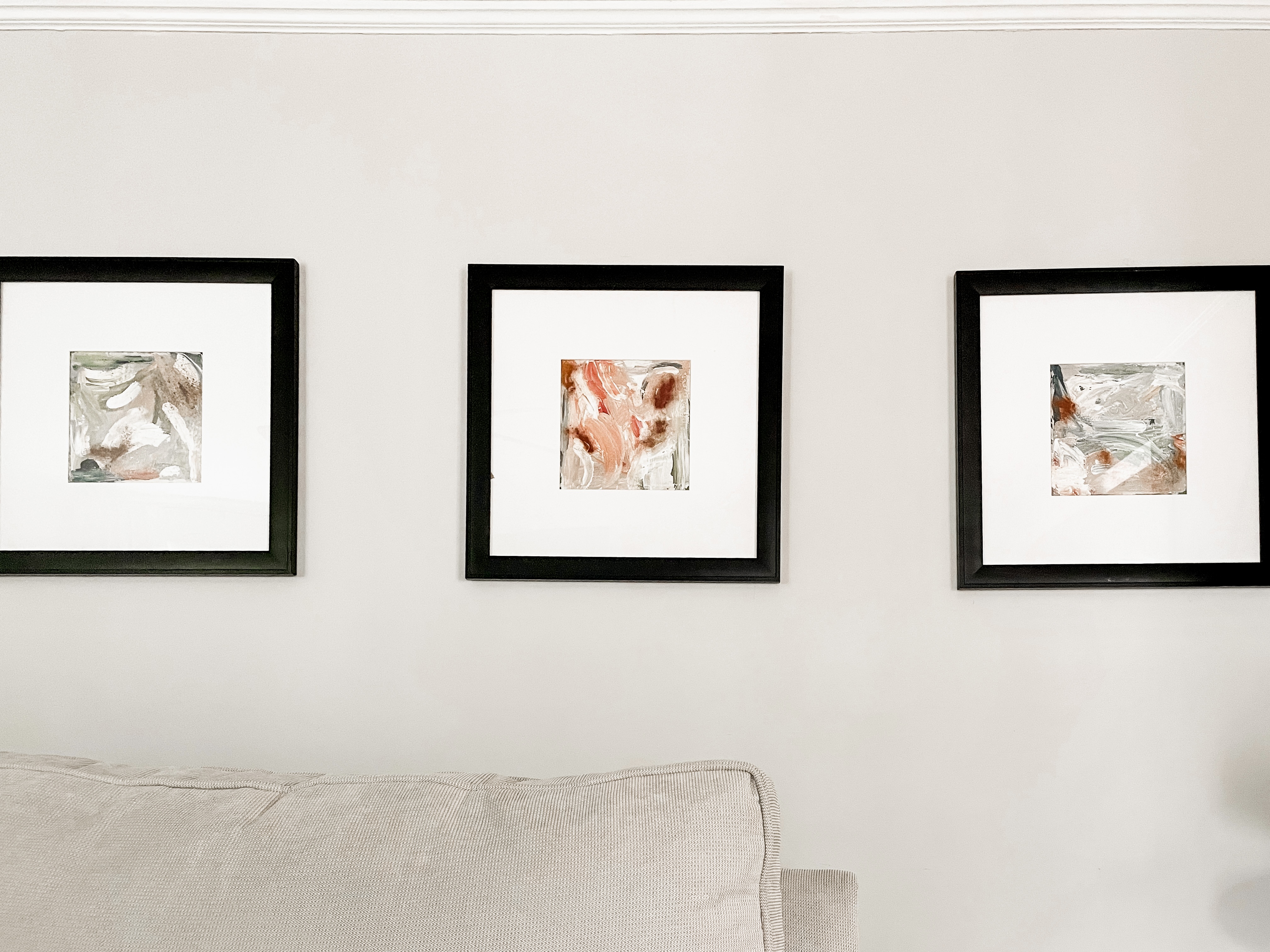
Do you have unsightly framed art? Give it a creative makeover with this DIY textured abstract wall art tutorial. Follow along as I teach you step by step how to complete this fun and easy project. No prior artistic ability required!
My parents donated this restaurant art to our new house when we were looking at nothing but blank walls. They are a great large size with quality mat and black frames. The only problem: the art was close up photos of bread and produce (any guesses to which restaurant these came from??)

I had planned to print images from Etsy or Collection Prints to cover the vegetable art, but could never find a set of 3 I loved that would bring subtle color into our living room space. After a year of the vegetable art sitting in the living room on the floor, my husband pleaded I do something with it. I decided to try my hand at creating DIY textured abstract wall art.
**Haven’t heard of Collection Prints? I still plan on purchasing images from here for elsewhere in my house. You can buy the downloadable image and print it yourself at a big box store, a local print shop, or somewhere like Shutterfly, or buy the print matted and framed already. They have a great selection that changes seasonally, and even better prices! Check it out here. They are offering a buy one, get one 50% off sale right now.
To DIY your own textured wall art, heres what you’ll need:

This post contains affiliate links for your convenience which may reward me in the event of a sale. Note that I only recommend tools and products I have personally used and loved.
SUPPLIES TO CREATE DIY TEXTURED ABSTRACT WALL ART
Something to paint on- you can start with a blank slate and use a canvas, or cover unsightly art that was donated to you or thrifted
Acrylic Paint
Craft Paint Brushes
STEP 1: Tape
I taped around the area I wanted to texturize to keep the joint compound and paint in the right place. I didn’t want to add texture to the area that would be under the mat in frame in case the thickness would cause issues with re-framing.

STEP 2: Joint Compound
To add texture to the base of the canvas, I used DryDex joint compound we had leftover from mudding the living room walls. This joint compound goes on pink, and dries white. I used my hands to apply the joint compound in a random, abstract manner. So much of this project is really up to you! Try to be random and not to think too much. I stopped once I had covered up all of the old art. Some areas were thin, and some were thicker. Because it was thick in some areas, I allowed 24-48 hours of dry time.
STEP 3: Paint
A Pinterest search is where I always start to find inspiration. With my set of 3 canvases, I knew I wanted to add some color to an otherwise very neutral living room space with my DIY textured abstract wall art. Recently, I had added a vintage Turkish area rug that I love to the living room and wanted to pull some colors from that onto the walls.
I came across this paint palette art from Emily Jeffords. I loved the colors and textures. This is what I tried to re-create. It’s important to pull multiple inspiration photos so your final product looks custom, rather than an imitation of someone else’s work.
Before we keep going, I think it’s important to share the “creative process” I came across on Tara’s website Tara Lenney Designs. It is accurate, so know you will go through all phases before deciding you love your work at the end.
I started by using multiple paint brushes to apply paint in an abstract manner. I chose 4-5 colors per canvas, including white and tan for each. This technique is all about trial and error, and realizing if you make a mistake or don’t love something, you can paint over it. I wasn’t quite getting the “paint pallet” look I was going for, so I changed up my technique.

Instead, I tried squirting paint directly onto the canvas to get a thicker, more textured application. Remember, be random! That’s hard for me- I am typically such a calculated and planned person. This second layer of paint squirted directly on the canvas helped give the project the paint pallet look I was going for by adding even more texture. I started with a neutral base layer, then added depth with more blends of the same colors, and started to introduce accent colors.

If you are struggling, try rotating your canvas and looking at the project from a different angle. Getting a new perspective can be powerful. Also, don’t be afraid to walk away from it and come back later. This is a good strategy to practice to know when to stop.
Finally, I loved the powdered pigmented layer on Emily Jefford’s art. I decided to use cooking spices to get a similar effect. After I was happy with how the paint layers looked, I randomly sprinkled Turmeric on one, Cinnamon on another, and Paprika on the last. My husband looked at me like I was crazy, but it worked!

Want to save to read later? Pin it here!
STEP 4: Dry, Frame & Hang your DIY Textured Abstract Wall Art
I let the art dry, allowing at least 48 hours to accommodate for the thick layers of paint. Once dry, I re-framed the art and hung it on the wall. Want a tip to get frames to hang AND stay straight? Check out my post here to learn how I achieved and maintained a straight hang with a nine piece gallery wall.

Thankfully, I love them! The set looks great from far away, but even better up close. You can see the texture from the joint compound, layered with the brush strokes and powdered pigment from the kitchen spices.
The best part? This project was made solely with supplies I already had on hand so it was free. Be sure to pin this project so you can find it when you are ready to make your own.
















